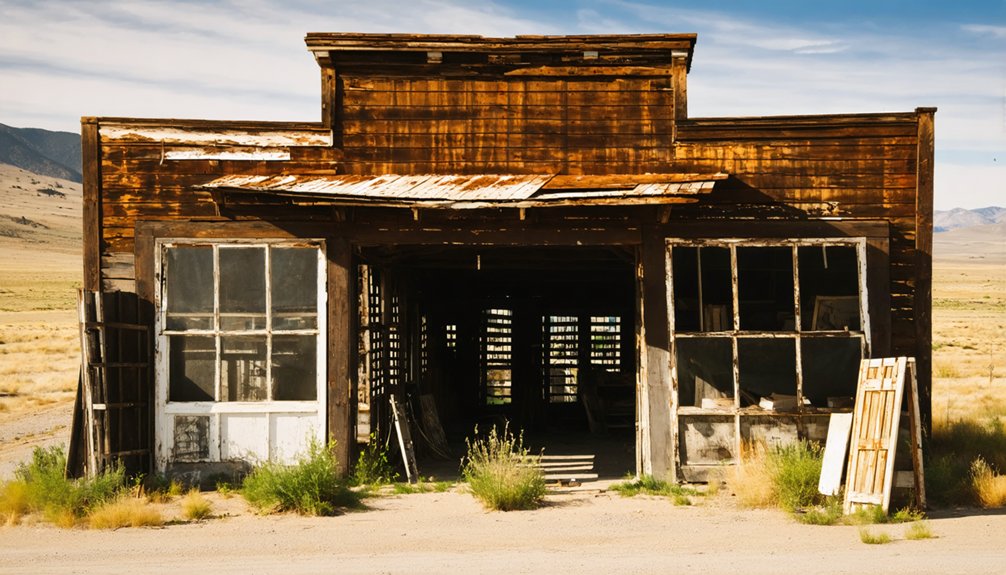You’ll find Leesburg’s weathered ruins nestled in Idaho’s mountains, where F.B. Sharkey’s 1866 gold discovery sparked a remarkable boom town. Within months, the population surged from 500 to 7,000 as fortune seekers built forty structures, including stores and blacksmith shops. Named after Confederate General Robert E. Lee, the town drew Civil War veterans from both sides, Chinese miners, and Montana prospectors. Today, about 25 deteriorating structures tell a rich story of Idaho’s golden age.
Key Takeaways
- Leesburg became a ghost town after its 1866 gold rush peak of 7,000 residents dwindled to just 180 people by 1870.
- The town originated when F.B. Sharkey discovered gold in 1866, quickly growing to 40 buildings including stores and blacksmith shops.
- Named after Confederate General Robert E. Lee, the town reflected Civil War divisions with Union supporters establishing nearby Grantsville.
- Approximately 25 deteriorating structures remain today, including log cabins and ruins, earning National Register of Historic Places status in 1975.
- Chinese miners arrived after 1870, successfully working abandoned claims while the original mining population departed.
The Birth of a Mining Boom Town
In the summer of 1866, a pivotal gold discovery transformed a remote mountain basin in Idaho’s Salmon River range into the bustling town of Leesburg. F.B. Sharkey and his four companions from Deer Lodge, Montana struck gold on July 16th, releasing a wave of fortune seekers to this promising new district.
You’d have witnessed an incredible transformation as miners rushed to stake their claims, working the shallow placer deposits that yielded up to $16 per day.
Within just one month, nearly 500 residents called Leesburg home. The promise of gold spurred rapid development, with forty buildings rising from the wilderness that first year alone. The town established essential services including stores and blacksmiths to support the growing population.
Drawn by gold’s allure, Leesburg exploded from untamed wilderness to a booming settlement of 500 souls within mere weeks.
Remarkably, the town’s growth pulled so many people from Montana’s capital that it temporarily emptied – a demonstration to the magnetic power of this new gold discovery.
At its height, the settlement grew into a thriving community with over 3,000 residents and thousands more in the surrounding mining basin.
Gold Rush Fever in the Mountain West
You’ll find a familiar pattern in how Leesburg emerged during the broader Mountain West gold fever of the 1860s, as prospectors rushed from California’s depleted claims to Idaho’s promising new territories.
Following the discovery of rich deposits in the mountains near Salmon River, thousands of fortune seekers converged on the region, staking claims that yielded impressive amounts of placer gold. Many of these miners had originally made their way to California by sailing around the treacherous Cape Horn route. The exodus to new territories was spurred by President Polk’s State of the Union address confirming California’s gold discovery.
While many prospectors dreamed of striking it rich in Leesburg’s high-altitude claims, most would eventually abandon their mining ambitions as the easily accessible gold diminished, leaving behind yet another boom-and-bust chapter in Western mining history.
Prospectors Rush to Idaho
The discovery of gold at Pierce in 1860, where Orofino Creek meets Canal Creek, sparked one of the Mountain West’s most dramatic mineral rushes. You’d have found thousands of freedom-seeking prospectors flooding into Idaho Territory, armed with basic prospecting techniques like gold pans and sluice boxes.
By 1862, the Boise Basin exploded into the region’s richest gold district, producing an astounding $600,000 in gold per day. All public lands remained open for gold exploration, drawing countless prospectors to the region.
As you ventured through the territory, you’d have encountered a diverse mix of European Americans, Native Americans, and Chinese miners working claims with increasingly sophisticated mining equipment. The transition from simple panning to hard rock mining marked the evolution of extraction methods.
The rush transformed the landscape as boom towns like Idaho City, Placerville, and Centerville sprouted up, briefly making the Boise Basin the Pacific Northwest’s largest population center.
Rich Mountain Gold Claims
Mining fever gripped Rich Mountain during the 1860s as prospectors discovered promising gold-bearing quartz veins within its rugged, metamorphic terrain.
Like many historical mining operations that emerged in the Cordilleran orogenic system, Rich Mountain’s geology presented both opportunities and obstacles for early prospectors.
You’d have found both placer and lode deposits here, though the gold extraction proved challenging due to the area’s thin, erratic deposits and tough geology.
Like many gold districts in Idaho, prospectors used burlap sluices to improve their recovery of fine gold, though the labor-intensive process still tested their endurance.
Mining Dreams Turn Bust
Despite dreams of striking it rich that lured thousands to the Mountain West during the 1860s, most prospectors discovered that gold mining proved far more challenging than anticipated.
You’d find that for every successful strike, countless mining failures left broken men facing harsh realities. The boom-to-bust cycle transformed bustling camps into ghost towns practically overnight when claims ran dry.
Like many Western mining towns, Leesburg’s fate mirrored a familiar pattern – explosive growth followed by rapid decline. Similar to Colorado where over 18,000 mines now sit abandoned, these ghost towns serve as stark reminders of mining’s temporary prosperity.
By 1852, two hundred thousand fortune seekers had flooded into California seeking wealth in the goldfields.
While some entrepreneurs made fortunes supplying miners with equipment and necessities, most prospectors battled dangerous working conditions, disease, and depleted resources.
The stark reality was that you’d more likely strike it rich selling supplies to miners than actually finding gold in the mountain streams.
Life During the Peak Mining Years
While early prosperity attracted thousands of hopeful miners to Leesburg’s gold-rich landscape in 1866, life during the peak mining years proved volatile and challenging.
You’d find miners battling harsh weather conditions, with the 1867 season crippled by late snow and flooding that slashed production to just $250,000.
Despite these mining challenges, community resilience showed in 1868 when production skyrocketed to $100,000,000.
You’d see log cabins dotting the landscape as transient workers followed the gold, but permanent structures were rare.
By 1870, the population dwindled to 180 as visible placer deposits vanished.
Through the late 1800s, you’d notice Chinese miners becoming the predominant workforce, working claims others had abandoned while adapting to the camp’s high-risk, seasonal nature.
Cultural Diversity in Early Leesburg
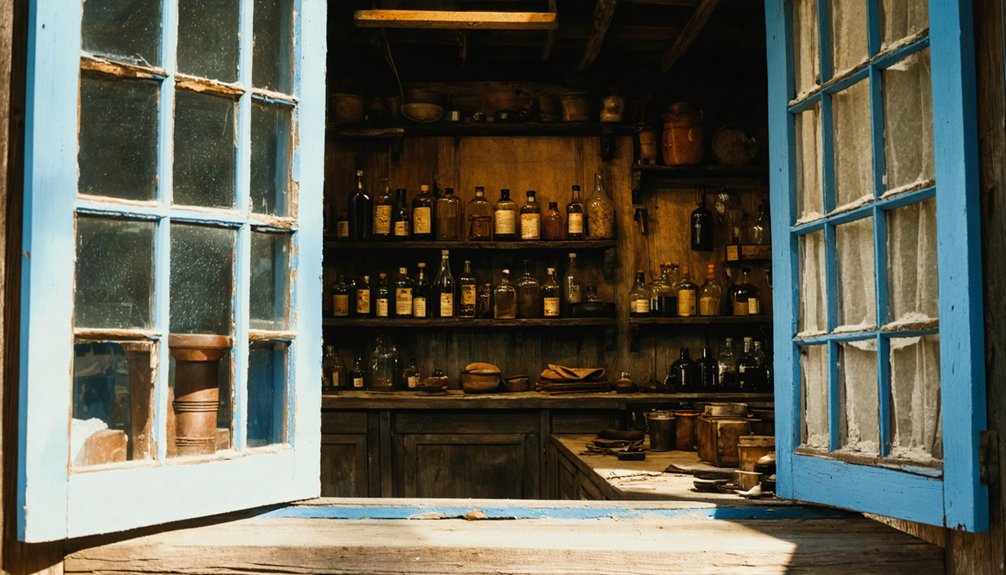
You’ll find that early Leesburg’s cultural landscape was shaped by two distinct groups of Civil War-era miners, with Confederate sympathizers from Idaho and Montana territories establishing Leesburg proper while Union supporters founded neighboring Grantsville.
The town’s diversity expanded further with a thriving Chinese community that worked the mines and maintained seasonal connections to Salmon, while European immigrants like the Scottish Barrack brothers developed agricultural enterprises in the Lemhi Valley.
These varied cultural influences created a complex social fabric where Confederate naming traditions, Northern political identities, and Chinese cultural practices existed alongside indigenous Shoshone linguistic influences in the region.
Civil War Miners Unite
As former soldiers from both sides of the Civil War converged on Leesburg in 1866, they brought with them distinctive cultural identities that would shape the mining town’s early development.
You’ll find evidence of their divided loyalties in the town’s geography, from the Confederate-inspired name to the Union settlers’ Grantsville district on Main Street’s east end.
Despite their past differences, military camaraderie emerged as veterans faced the harsh realities of frontier mining life.
You’d have witnessed these former soldiers working side by side, earning $8-20 daily in the goldfields while building a remarkably peaceful community.
Their economic adaptation proved essential as they established businesses, cleared winter trails, and maintained order.
When mining declined in the 1870s, many veterans successfully shifted to ranching, demonstrating the resilience that defined Leesburg’s character.
Chinese Community Takes Root
The arrival of Chinese miners in Leesburg marked a profound shift in the town’s demographics after 1870. When most Euro-American miners abandoned their claims, the Chinese community took root and flourished, bringing their distinct cultural practices and mining techniques to the area.
- Chinese miners worked cooperatively in larger households, averaging 3.4 persons compared to Euro-Americans’ 2.1.
- Their frugal and patient approach allowed them to profit from previously abandoned claims.
- You’ll find they maintained strong community cohesion through shared cultural activities, including joss houses and traditional games.
- During winters, they’d temporarily relocate to nearby Salmon’s Chinatown to preserve social connections.
- They developed an informal property system, managing claims communally rather than through official records.
This resilient community kept Leesburg’s mining operations viable well into the late 19th century, recovering several million dollars in gold.
Diverse Traditions Shape Town
While Confederate sympathizers originally named Leesburg after General Robert E. Lee, you’d find a surprisingly diverse mix of cultural influences shaping this mining boomtown.
Union supporters established their own settlement of Grantsville just north of Leesburg, creating distinct but interconnected communities that reflected the nation’s post-Civil War divisions.
The settlement dynamics went far beyond just North-South tensions. You’d encounter Montana miners working alongside seasonal laborers from various backgrounds, while Mormon farmers from Fort Lemhi supplied food to the camps.
The mining district’s original name, “Napias,” honored the Shoshone people’s word for gold, highlighting the area’s Indigenous connections.
Despite their differences, these varied groups found ways to cooperate in mining, commerce, and local governance, building a complex social fabric that defined early Leesburg.
The Rise and Fall of Local Commerce
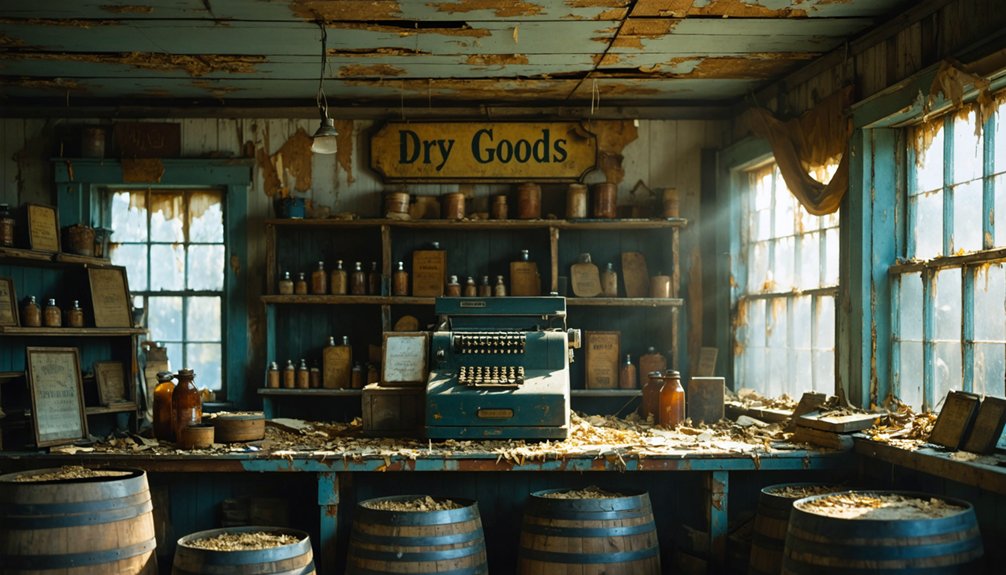
Following an 1866 gold discovery by five prospectors, Leesburg rapidly transformed from untamed wilderness into a bustling commercial hub that would serve thousands of miners.
The town’s commercial infrastructure expanded to over 100 businesses within two years, as market dynamics drove real estate prices skyward, with some lots fetching $3,000 in gold.
- Forty buildings sprang up in the first year, including stores, butchers, and blacksmiths.
- A crucial toll pack-trail to Salmon supplied food during harsh winters.
- Early supply gluts caused price instability as merchants competed for business.
By 1870, the exodus of miners triggered widespread business closures.
Brief revivals through hydraulic and dragline mining in the 1900s couldn’t restore Leesburg’s former commercial glory, leading to its eventual ghost town status.
Architectural Legacy and Remaining Structures
Standing as silent witnesses to Leesburg’s golden age, roughly 25 deteriorating structures remain from what was once a vibrant mining town of 150-200 buildings.
You’ll find simple log cabins built in the “Lincoln log” style, featuring basic one-room designs with stovepipe holes and canvas-covered interior walls. The architectural features reflect the frontier spirit, with locally sourced timber used in hand-built construction techniques that defined the era’s mining settlements.
Today, you can spot collapsed walls and foundations along the main street and northern paths, though many are obscured by vegetation.
The buildings that once housed stores, saloons, and Chinese merchants now exist mainly as scattered ruins. Notable structures include log barns with haylofts predating 1908, proof of the community’s agricultural aspects.
Notable Characters and Stories
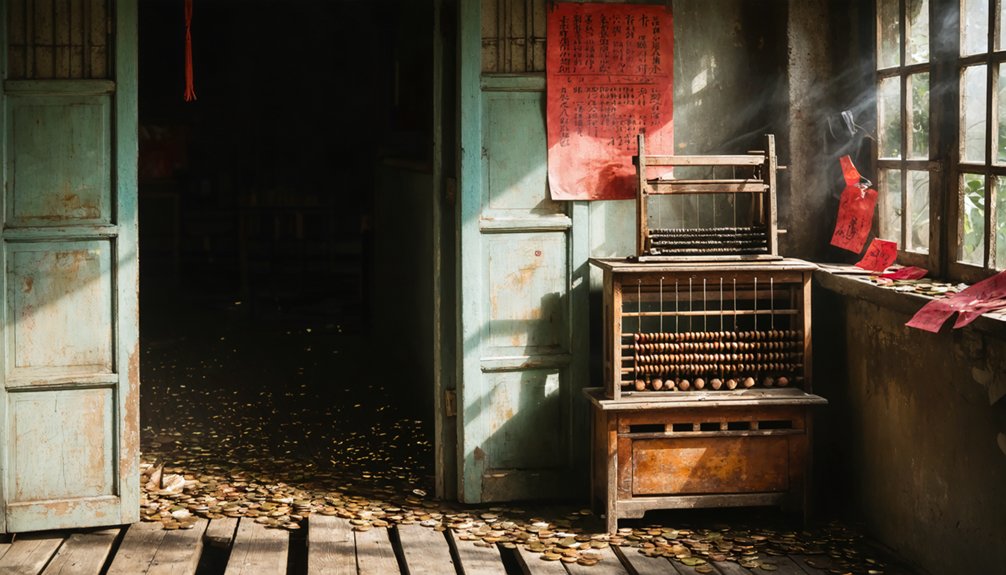
You’ll find that Leesburg’s founding pioneers were led by F.B. Sharkey, who guided a party of five men to discover rich gold deposits along the Salmon River’s tributaries in 1866.
The town’s establishment reflected the complex dynamics of post-Civil War America, as Confederate sympathizers named the settlement after Robert E. Lee, while Union supporters initially created a separate camp called Grantsville that later merged into Leesburg.
These early mining leaders helped build a remarkably cooperative community that grew to include over 100 businesses, setting Leesburg apart from the typical lawless atmosphere of other Western mining camps.
Pioneer Mining Leaders
When Frank Barney Sharkey and his four companions discovered gold in 1866, they couldn’t have known they’d spark one of Idaho’s most significant mining rushes. The pioneer miners’ leadership dynamics shaped Leesburg’s unique character, establishing a cooperative spirit that set it apart from typical rowdy mining camps.
- Sharkey and his team filed the first claims, setting standards for organized prospecting.
- Union supporters carved out their own district called Grantsville on Main Street’s east end.
- Early leaders encouraged systematic claim development, with 3,000 claims filed by fall 1866.
- Mining operators maintained peaceful relations despite intense competition for resources.
- Pioneer leaders fostered a community-focused approach that drew merchants, craftsmen, and families.
Unlike other boom towns, Leesburg’s founders created an environment where miners could earn $20+ daily while building a stable community.
Civil War Roots
The profound influence of the Civil War reached far beyond the battlefields of the East, shaping the very foundations of Leesburg, Idaho.
You’ll find the town’s Confederate heritage in its very name, honoring General Robert E. Lee, while just nearby, Union sympathizers established their own settlement of Grantsville.
The Civil War’s community impact extended throughout the region as Confederate refugees, particularly from Missouri, sought new beginnings in Idaho’s promising frontier.
These settlers brought their Southern cultural influences and Democratic political leanings, transforming the area’s social fabric. They established farms and ranches, supplying essential resources to the booming mining communities.
Today, you can still trace the war’s legacy in Idaho’s historical narrative, place names, and preserved cultural sites that tell the story of this fascinating chapter in Western history.
From Bustling Town to Historical Site
As gold discoveries sparked Leesburg’s explosive growth in 1866, few could have predicted its eventual transformation from a bustling mining hub into a protected historical site.
The town’s unique community spirit and mining ethics set it apart from typical gold rush settlements, fostering cooperation rather than conflict. You’ll find it remarkable that within months, the population surged to 3,000, then peaked at 7,000 in the basin.
- Forty buildings sprang up in 1866, including stores and blacksmith shops
- Mining yielded up to thirty cents per pan during peak operations
- Population declined sharply after 1870 as gold deposits dwindled
- Brief revivals through hydraulic and dragline mining proved unsuccessful
- By 1975, the ghost town earned National Register of Historic Places status, preserving its gold rush legacy
Exploring Leesburg Today
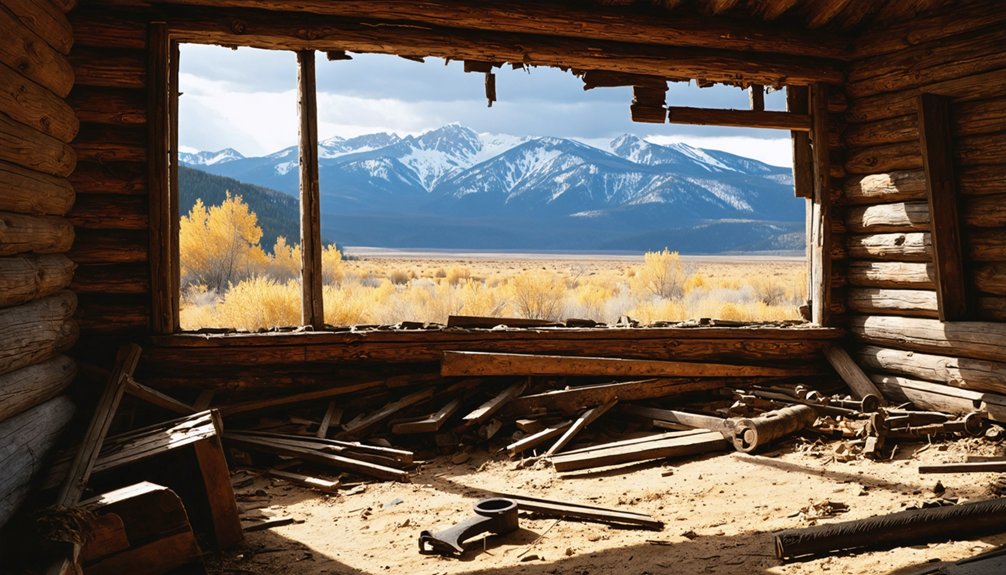
Modern-day visitors to Leesburg find themselves surrounded by towering pines at 6,653 feet elevation, where crumbling remnants of Idaho’s gold rush era still dot the landscape.
You’ll discover a ghost town exploration paradise within the Salmon-Challis National Forest, where gravel roads lead to abandoned structures and old mining sites listed on the National Register of Historic Places since 1975.
While historical preservation challenges persist due to harsh winters and time’s toll, you can still trek through this atmospheric site during summer months.
Though weathered by seasons and years, this ghostly mountain settlement beckons summer adventurers to wander its historic grounds.
The area offers prime hiking and photography opportunities among the scattered ruins. As you explore, you’ll encounter traces of the town’s rich past, though many original structures have vanished.
Remember that unmarked graves lie throughout the site, demanding respectful navigation of this historic treasure.
Preserving Idaho’s Mining Heritage
Beyond Leesburg’s weathered structures lies a broader story of Idaho’s mining legacy that demands active preservation.
You’ll find that heritage preservation efforts across the state involve multiple organizations working to protect these historic treasures while balancing environmental concerns.
- The State Historic Preservation Office maintains essential mining sites on the National Register of Historic Places
- Local communities and tribal groups actively participate in protecting cultural resources
- Heritage tourism helps fund preservation while boosting local economies
- Modern preservation efforts must address the environmental impact of past mining operations
- The Mining Law of 1872 still influences how we manage these historic sites today
Through responsible mining history preservation, you’re not just protecting old buildings – you’re safeguarding the stories, technologies, and cultural significance that shaped Idaho’s identity.
These sites serve as living classrooms for future generations.
Frequently Asked Questions
What Dangerous Wildlife Might Visitors Encounter in the Leesburg Area Today?
You’ll need to watch for black bears and rattlesnakes, with bear encounters most likely in forested areas and snake sightings in rocky terrain. Mountain lions, wolves, and moose can pose threats too.
Is Camping Allowed Near the Ghost Town Site?
In this million-acre playground, you’re free to set up camp near the site. While camping regulations allow dispersed stays up to 14 days, you won’t find ghost town amenities—pack everything you’ll need.
How Severe Are Winters in Leesburg, and When Is Best to Visit?
You’ll face harsh winters with temps dropping below zero and heavy snow. Skip winter activities unless you’re well-equipped. Summer and early fall are ideal seasons, offering warm days and clear access.
Are Metal Detectors Permitted at the Leesburg Ghost Town Site?
You’ll need permits and landowner permission for metal detecting due to regulations protecting historical artifacts. Don’t disturb archaeological sites, and remember finds belong to property owners under Idaho’s preservation laws.
What Was the Total Value of Gold Extracted From Leesburg?
Though early estimates suggested modest yields, historical gold mining records show you’re looking at roughly $5.4 million in total extracted value through 1959, equivalent to about 271,200 ounces of precious metal.
References
- https://pinintheatlas.com/travel-blogs/ghost-towns-of-idaho/
- https://www.youtube.com/watch?v=1hF2mr–zTs
- https://westernmininghistory.com/towns/idaho/leesburg/
- https://www.youtube.com/watch?v=AQMyV46_T1I
- http://idaho.com/history/leesburg/
- https://history.idaho.gov/wp-content/uploads/2018/09/Leesburg_75000634.pdf
- https://www.visitsalmonvalley.com/historic-adventures/ghost-towns/
- https://history.idaho.gov/wp-content/uploads/0203.pdf
- https://tile.loc.gov/storage-services/master/pnp/habshaer/id/id0100/id0172/data/id0172data.pdf
- https://www.britannica.com/topic/California-Gold-Rush
